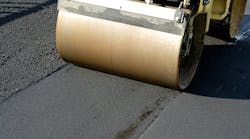Maintenance Pervades in Pervious Concrete
Today, landowners and developers increasingly are incorporating alternate best management practices (BMPs) for storm water management into their designs. BMPs such as rain gardens, bioswales and infiltration systems provide them with an effective means to promote more sustainable development while adhering to strict storm water regulations. It is important for owners and developers to understand that these alternate systems may require maintenance procedures different from those of more conventional and familiar BMPs.
Pervious concrete pavement, for example, is a permeable pavement surface—typically with an underlying stone reservoir—that temporarily stores surface runoff before it infiltrates into the subsoil. As such, a pervious concrete pavement is an intricate part of an engineered infiltration system for storm water management. The solution requires specific maintenance to maintain its efficacy. In addition to owners not being aware of pervious pavement on a site, not performing these maintenance activities is the chief reason for failure of the pervious pavement/storm water system.
Cleaning
The majority of pervious concrete pavements will function well with little or no maintenance. There may be instances, however, in which sand, dirt, leaves and other debris infiltrate the void structure of the pervious concrete and inhibit its permeability. In most cases, the clogging is limited to the first 1 in. to 1.5 in. of the pavement thickness. Routine cleaning can help avoid this situation and restore the pervious concrete’s permeability.
A study by the University of Central Florida (UCF) looked at three standard maintenance practices for cleaning pervious concrete. The cleaning techniques investigated were pressure washing, vacuum sweeping and a combination of these two methods.
Pressure washing dislodges the clogging particles, washing a portion off site and flushing the remaining portion through the pavement surface. Vacuum sweeping with a regenerative vacuum sweeper dislodges dirt and debris by means of the sweeping action and removes them via the vacuum. Results of the UCF study show that utilizing these cleaning practices individually or in combination can improve the infiltration rate of a clogged pervious concrete pavement by 90% or more.
The study was funded by the Ready Mixed Concrete Research and Education Foundation. The complete report, “Construction and Maintenance Assessment of Pervious Concrete Pavements,” can be found at www.rmc-foundation.org.
Periodic cleaning and checking of the pavement’s porosity and rate of water percolation will help maintain the pavement/storm water system to ensure that it will remain functional as designed. Table 1 can serve as a minimal recommendation for scheduled maintenance.
Cold-Weather Considerations
Experience has shown that pervious concrete pavements in cold-weather climates tend to have an inherent ability to withstand freeze-thaw cycles. Freeze-thaw resistance of pervious concrete appears to depend on the saturation level of the voids in the concrete at the time of freezing. Field observations have shown that the rapid draining characteristics of pervious concrete prevent saturation from occurring.
It is important to understand that the porosity of pervious concrete from the large voids is distinctly different from the microscopic air voids that provide protection to the paste in conventional concrete in a freeze-thaw environment. When the large voids are saturated, complete freezing can cause severe damage to the pervious concrete pavement. Thus, it is critical to protect and maintain the void structure of pervious concrete in order to ensure cold-weather durability.
Anecdotal evidence also suggests that snow-covered pervious concrete clears more quickly, possibly because its voids allow the snow to melt more quickly than it would on conventional pavements. Mechanical removal of ice and snow can be accomplished using snowblowers or snowplows. Because of its rigid nature, pervious concrete pavement is less susceptible than other flexible paving materials to damage from snowplowing.
The void structure of pervious concrete pavement may facilitate a faster thawing of ice and snow on the pavement surface compared with impervious pavements at temperatures modestly below freezing. Therefore, deicing chemicals and anti-skid materials are needed much less often than on conventional pavements.
If necessary, deicing chemicals and anti-skid materials can be used sparingly. Deicing chemicals should never be applied to concrete that is less than one year old. Deicing agents containing sodium chloride or calcium chloride may be used on mature concrete surfaces. At no time should deicing agents that contain fertilizer ingredients such as ammonium sulfate and ammonium nitrate be used, as these may chemically attack the concrete surface. In the event that anti-skid materials are used, a thorough cleaning of the surface should be completed following the cold-weather season.
Surrounding Areas
Drainage of all unpaved areas should be directed away from the pervious concrete pavement. If areas are allowed to drain onto the pavement, suspended materials may wash into the concrete’s voids and eventually reduce its porosity and compromise its service life. At the outset, proper design and construction, including installation of curbs where appropriate, can ensure a controlled flow path of storm water during a storm event and minimize the flow of debris onto the surface of the pervious concrete pavement.
Materials that may impact the porosity of pervious concrete pavement, such as sand, leaves and mud, may be conveyed by wind, automobile traffic or other means. Periodic cleaning of the pavement will minimize the effect of this debris and help maintain the necessary permeability adequate for the pavement/storm water management system’s designed function. Additionally, landscaping materials such as mulch and topsoil should not be stored on the pavement, even temporarily.
Ownership, Responsibility & Results
Keeping the pavement clean—and within design specifications—is the owner’s responsibility. The best maintenance practice appears to be prevention.
Maintenance of pervious concrete pavement consists primarily of prevention of clogging of the void structure. Proper design and construction of pervious concrete, taking into consideration the drainage of surrounding areas to prevent the flow of potentially clogging materials onto the pavement surface, can minimize maintenance concerns. When maintenance requirements are realized by the owners, the longevity of this pavement option is very viable.
Download: Here

